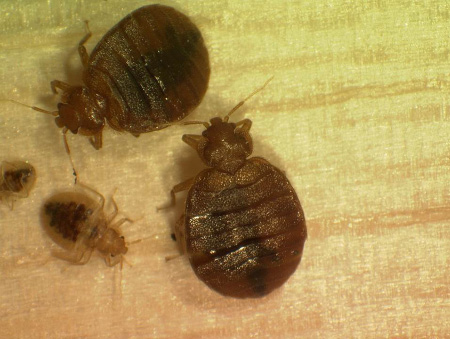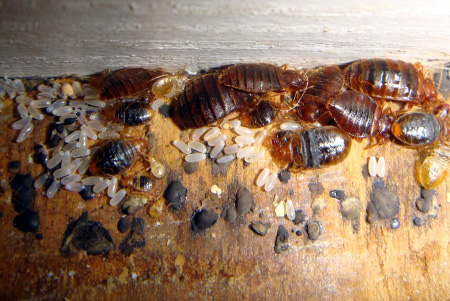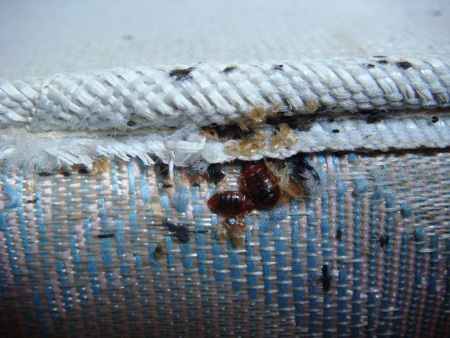Bed Bugs: Difficult Pests to Control in Poultry Breeder Flocks
The common bed bug (Cimex lectularius L.) is a hematophagous (feeds on blood) insect that can be a major pest in poultry breeder facilities. Several other species exist and are occasionally important, including the bat bug (C. pilosellus), the barn swallow bug (Oeciacus vicarious), and the poultry bug or Mexican chicken bug (Haematosiphon inodorus) (Roe, 2000). However, the common bed bug is the most often-encountered species. Bed bugs belong to a family of insects called Cimicidae.
Members of this insect family are small, oval, flat, hard-bodied, flightless insects in which the wings are absent or reduced to stubs (Figure 1). All members of this family of insects feed exclusively on blood.

thousands of years and are making a comeback.
Bed bugs have been around for thousands of years; they are mentioned in medieval European texts and classical Greek writings back to the time of Aristotle (Potter, 2012). However, many people in the United States have no knowledge of them because they have not been a problem for 50 years or more. They remained in check by use of synthetic insecticides. However, the increased use of localized baits, the reduced use of insecticide sprays for control of cockroaches and ants (which also helped control bed bugs), the availability of less effective insecticides on the market, the lack of public awareness, and a decrease in societal vigilance has helped fuel the current bed bug resurgence.
Life Cycle
The life cycle of the common bed bug consists of the egg, five stages of nymphs (each progressively larger than the preceding), and adults (Steelman, 2000) (Figure 2). Each immature nymph stage must take a blood meal in order to develop into the next stage. Like all insects, bed bugs have their skeleton on the outside of their bodies (exoskeleton) and, therefore, must shed their exoskeleton in order to grow larger (Miller and Polanco, 2013). Adult bed bugs must also take regular blood meals to reproduce. Adult bed bugs are reddish-brown in color, while the nymphs and eggs are yellowish-white.
Three to four generations per year are possible, although one or two generations are usually more common. A female bed bug can lay 50 to 350 eggs in her lifetime. Eggs usually hatch in about 10 days. However, at temperatures above 70°F, eggs can hatch 6 to 17 days after laying; they may take up to 28 days at lower temperatures (Roe, 2000). The time within each of the five nymph stages depends upon the temperature and how soon the nymphs are able to obtain a blood meal. In a poultry facility, because the chickens provide a readily available blood supply, temperature is usually the determining factor. At 80°F, the interval between nymph stages is about 4 days. Therefore, the entire life cycle from egg to adult requires about 30 days (Steelman, 2000). Both nymphs and adults can survive several months without a blood meal. This makes it quite easy for a bed bug infestation to survive through the downtime between breeder flocks and then, once a new flock is placed, start feeding on the new flock.

Recent Resurgence
Bed bugs have recently regained worldwide attention because of their resurgence into dwellings shared by humans, such as homes, hotels, apartments, homeless shelters, and college dorm rooms (Figure 3). In the developed world, bed bugs were thought to have been largely eradicated as pests in the 1940s and 1950s due to the widespread use of DDT. However, populations have always existed in locations such as Central and South America, Europe, Africa, and the Middle East. It is possible that populations were never truly wiped out in the United States. Bed bugs may have simply found alternate hosts (chickens, for example) for a few years as their numbers increased.
Reasons for their recent resurgence are not fully understood but may include increased long-range air travel, ability of bed bugs to disperse locally, reduction in the use of residual insecticides, and movement of bed bugs from birds to bats to domesticated birds and then to humans (Steelman et al., 2008). Insecticide resistance in bed bugs is a serious problem, having first been observed with DDT (Lofgren et al., 1958), later with malathion and diazinon (Feroz, 1968), and, more recently, with pyrethroids (Romero et al., 2006). This current resurgence trend could be a result of increased use of insecticide baits, which bed bugs do not consume, to control cockroaches and similar pests, and a lower number of active ingredients effective against bed bugs.
Although active dispersal of bed bugs can be important, passive dispersal is almost exclusively their dispersal method (Steelman et al., 2008). Bed bugs are very efficient at hitchhiking and can be transported in or on luggage, clothing, beds, furniture, and so forth. They can easily move from the chicken house to your dwelling house on clothes, shoes, or purses. Bed bugs can arrive at poultry facilities as eggs, nymphs, or adults attached to boxes, clothing, cages, slats, litter removal equipment, or other equipment brought from infested poultry facilities. They can also arrive on replacement roosters or on pullets and roosters when a new breeder flock is placed on the farm.

Behavior and Control
It only takes one female to cause serious problems. One impregnated female bed bug can produce a well-developed infestation in the breeder house within a few months. She does not need a male present for this to happen. While it is true that she will eventually run out of sperm and have to mate again to fertilize additional eggs, she can mate with her own offspring after they become adults to continue the cycle. Due to the large number of eggs that a female can produce under the right conditions and with access to a host, bed bug populations can eventually double every 16 days.
Bed bugs have a unique method of mating called traumatic insemination. In traumatic insemination, because the female’s body has no natural opening for reception of sperm, the male’s reproductive organ is stabbed through the female’s body wall and releases sperm into the female’s body cavity. Over the next several hours, the sperm migrate to the ovaries and fertilize the eggs. Studies have shown that the process of healing from traumatic insemination has a significant impact on the female’s ability to produce eggs. Females that mate only once will produce 25 percent more eggs than females that are mated repeatedly (Miller and Polanco, n.d.). Access to blood meals will determine how many eggs a female will produce in her lifetime. The more meals she is able to take, the greater the number of eggs she will produce.
Bed bugs are, for the most part, nocturnal insects. However, they may occasionally feed during the day if extremely hungry and the light levels are dim. They spend the majority of their time hiding in cracks and crevices where they are unseen and will not be disturbed. This makes them very difficult to control in breeder houses because of the abundance of hiding places such as slats, nest boxes, curtain folds, and numerous cracks and crevices. The young and adults of both sexes feed exclusively on blood. They have beak-like mouthparts that pierce the skin of the host and allow them to withdraw blood. A bed bug will feed for 5 to 10 minutes, after which it will leave its host and return to a hiding place to begin digesting its meal. Bed bugs generally feed every 3 to 7 days. Therefore, at any given time, most bed bugs are hiding out and digesting a meal, not feeding on your chickens.
Heavy infestations of bed bugs in chicken houses may lead to excessive feather loss, cloacal irritation, lesions on the breasts and legs, and possibly anemia in severe cases (Goddard and Edwards, 2012). Because of the stress a severe infestation can place on a breeder flock, production may suffer. This could be in the form of fewer egg numbers, lower fertility, and/or decreased hatchability. Feed intake and feed per dozen hatching eggs may also be affected. Even though bed bugs feed on the blood of humans, chickens, and other warm-blooded creatures and are a major nuisance for those individuals dealing with an infestation, they apparently do not transmit disease. However, and especially if they move from the chicken house to your dwelling house, infestations can cause insomnia, discomfort, embarrassment, and anxiety.
Bed bugs are very difficult to control, especially with birds on the farm. Many products no longer work well because of insecticide resistance, and insecticide applications must reach harborage locations (not the birds), which is not always possible. In addition, labeling applications limit the number of products that can be applied when birds are present. Some products that can be used with birds on the farm include permethrin formulations, Ravap EC (tetrachlorvinphos and dichlorvos), and Rabon. It is usually easier to gain control of a bed bug infestation after the birds have been removed and the houses thoroughly cleaned and disinfected. After cleaning, an insecticide with good residual activity can be applied to cracks, crevices, curtains, ceiling seams and attics, nest boxes, slats, and other harborage sites. Insecticides with residual activity labeled for use when birds are not on the farm include OxyFly (Lamba-cyhalothrin), Tempo 20WP (Cyfluthrin), and Tempo SC Ultra (beta-cyfluthrin). Diatomaceous earth has also been used as an alternative to chemical insecticides with varying degrees of success that seem to be somewhat weather-dependent (applying when the humidity is low seems to work better than when humidity is high).
Heat treatment can be used to kill bed bugs when chickens are absent from the facility. Sustained heating of the structure to 130°F for a few hours should kill the bed bugs and their eggs. It would be best to contact a pest management professional to determine if the company has the equipment and expertise necessary to heat treat a structure as large as a breeder facility. An outside-perimeter, residual insecticide application is also recommended to kill bed bugs trying to escape from the heat.
Summary
Bed bugs are blood-feeding insects that are very difficult to control in poultry breeder houses. They have been around for thousands of years, but most people in the United States (including many entomologists) had never seen one until recently because they were thought to have been almost wiped out in this country. However, that was not the case, and they have made a dramatic resurgence over the last 10 to 20 years. They are extremely difficult to control in breeder operations if there are birds on the farm. Products that can be used with birds present are limited, and many products no longer work extremely well because the bugs have developed at least some level of resistance to many chemicals that have been used in the past.
Generally, the pests are easier to control in between flocks when the house can be cleaned, disinfected, and treated with stronger chemicals that are labeled for use only when the birds are gone and the house is empty. Diatomaceous earth is an alternative to chemical treatment. Even with the birds gone, however, treating the house may not result in total eradication. There are simply too many hiding places in a chicken house. You must constantly, vigilantly monitor your houses.
A note of caution: Not all chemical products may be legal in your state. Check with your integrator, county Extension office, or other regulatory official before using any insecticide in or around your poultry houses. Even if a product is legal in your state, CHECK WITH YOUR INTEGRATOR BEFORE USING to make sure it is on their approved list of products safe to use in or around chicken houses. ALWAYS READ AND FOLLOW LABEL DIRECTIONS FOR SAFE USE OF ANY PESTICIDE!
References
Feroz, M. 1968. Toxicological and genetical studies of organophosphorus-resistance in Cimex lectularius L. Bull. Entomol. Res. 59: 377-382.
Goddard, J. & K. T. Edwards. 2012. What to do about bed bugs in poultry houses. Mississippi State University Extension Service, Information Sheet 1945.
Lofgren, C. S., J. C. Keller, & G. S. Burden. 1958. Resistance tests with the bed bug and evaluation of insecticides for its control. Journal of Economic Entomology, 51: 241-244.
Miller, D. M. & A. Polanco. 2013. Bed bug biology and behavior. Virginia Tech, Publication ENTO-8P.
Potter, M. F. 2012. Bed bugs. University of Kentucky Cooperative Extension Service, Entomology Fact Sheet No. 636.
Roe, A. H. 2000. Bed bugs. Utah State University Extension, Fact Sheet No. 93.
Romero, A., M. F. Potter, D. A. Potter, & K. F. Haynes. 2006. Insecticide resistance in the bed bug: A factor in the pest’s sudden resurgence? Journal of Medical Entmology, 44: 175-178.
Steelman, C. D. 2000. Biology and control of bed bugs. Avian Advice, 2(2): 10,15. University of Arkansas Cooperative Extension Service.
Steelman, C. D., A. L. Szalanski, R. Trout, J. A. McKern, C. Solorzano, and J. W. Austin. 2008. Susceptibility of the bed bug Cimex lectularius L. (Heteroptera: Cimicidae) collected in poultry production facilities to selected insecticides. Journal of Agricultural Urban Entomology, 25(1): 41-51.
Publication 2881 (POD-03-18)
By Tom Tabler, Extension Professor, Poultry Science; Jessica Wells, Extension Instructor, Poultry Science; Kelly M. Loftin, Director of Experiment Station, University of Arkansas Cooperative Extension Service; Morgan Farnell, Associate Professor, Poultry Science, Texas A&M Agrilife Research; and Haitham M. Yakout, Manager of the Paul Siegel Poultry Research Center, Poultry Sciences, Virginia Tech. Photos courtesy of Dini Miller and Molly Stedfast, Virginia Tech Entomology Deparment.The Mississippi State University Extension Service is working to ensure all web content is accessible to all users. If you need assistance accessing any of our content, please email the webteam or call 662-325-2262.





